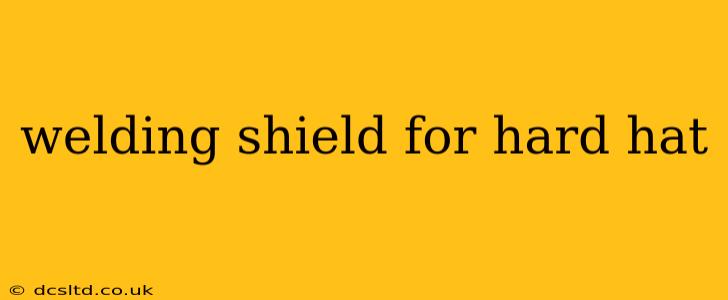Welding is a crucial process in many industries, but it comes with inherent dangers. Protecting your eyes and face from intense UV radiation, sparks, and spatter is paramount. A welding shield, often integrated into a hard hat, is your primary line of defense. This comprehensive guide explores everything you need to know about choosing and using a welding shield for your hard hat.
What is a Welding Shield for a Hard Hat?
A welding shield for a hard hat is a specialized face shield designed to attach securely to the hard hat, offering comprehensive protection during welding operations. Unlike standalone welding helmets, these shields offer a lighter, more convenient option for tasks that don't demand the full coverage of a helmet. They typically feature a dark shade lens to filter harmful UV and IR radiation, protecting your eyes from damage. The attachment mechanism varies, but most use a robust clamping system to ensure a secure fit.
What are the Different Types of Welding Shields?
Several types of welding shields are available, each catering to specific needs and preferences:
- Flip-front shields: These shields allow you to quickly flip the protective lens up and down, offering convenient access while maintaining safety.
- Fixed shields: These shields offer a permanently attached lens. They are generally more durable but less versatile than flip-front models.
- Material variations: Welding shields are often made from polycarbonate, offering excellent impact resistance and clarity. Others might utilize impact-resistant glass.
How to Choose the Right Welding Shield for Your Hard Hat?
Selecting the appropriate welding shield involves considering several factors:
- Shade number: The shade number of the lens determines the level of protection it provides. Higher shade numbers offer more protection but reduce visibility. The correct shade number depends on the welding process. Consult the ANSI Z87.1 standard for guidance.
- Impact resistance: Opt for a shield made from high-impact polycarbonate for superior protection against flying debris and sparks.
- Compatibility: Ensure the welding shield is compatible with your hard hat's design and mounting system. Check manufacturer specifications.
- Comfort and fit: A comfortable and secure fit is crucial. The shield should fit snugly without obstructing your vision or causing discomfort.
What is the Best Shade Number for a Welding Shield?
The best shade number for your welding shield depends heavily on the welding process you're using. For example:
- Gas Metal Arc Welding (GMAW): Shade 10-12
- Gas Tungsten Arc Welding (GTAW): Shade 10-12
- Shielded Metal Arc Welding (SMAW): Shade 10-14
- Plasma Arc Welding (PAW): Shade 10-12
Always refer to the manufacturer's recommendations and relevant safety standards for accurate shade number selection. It's better to err on the side of caution and choose a higher shade number if unsure.
How Do I Attach a Welding Shield to My Hard Hat?
Attachment methods vary depending on the specific shield and hard hat model. Most shields use a clamp-on system, attaching securely to the brim or sides of the hard hat. Always follow the manufacturer's instructions for proper installation. Ensure the shield is firmly secured before starting any welding work. A loose shield significantly compromises safety.
Can You Use a Welding Shield Without a Hard Hat?
No, it's not recommended to use a welding shield without a hard hat. Hard hats provide crucial head protection from falling objects, impacts, and other hazards present in welding environments. Using a shield alone leaves you vulnerable to serious head injuries.
How Often Should I Replace My Welding Shield?
Regular inspection and replacement of your welding shield are crucial for maintaining optimal safety. Inspect it regularly for any cracks, scratches, or damage to the lens. Replace the shield immediately if any damage is found. Even minor imperfections can compromise protection. Consider the frequency of use when determining the replacement schedule.
This guide provides a thorough overview of welding shields for hard hats, emphasizing safety and best practices. Always prioritize your safety and comply with relevant safety regulations and guidelines. Remember, proper safety equipment is paramount in any welding environment.
